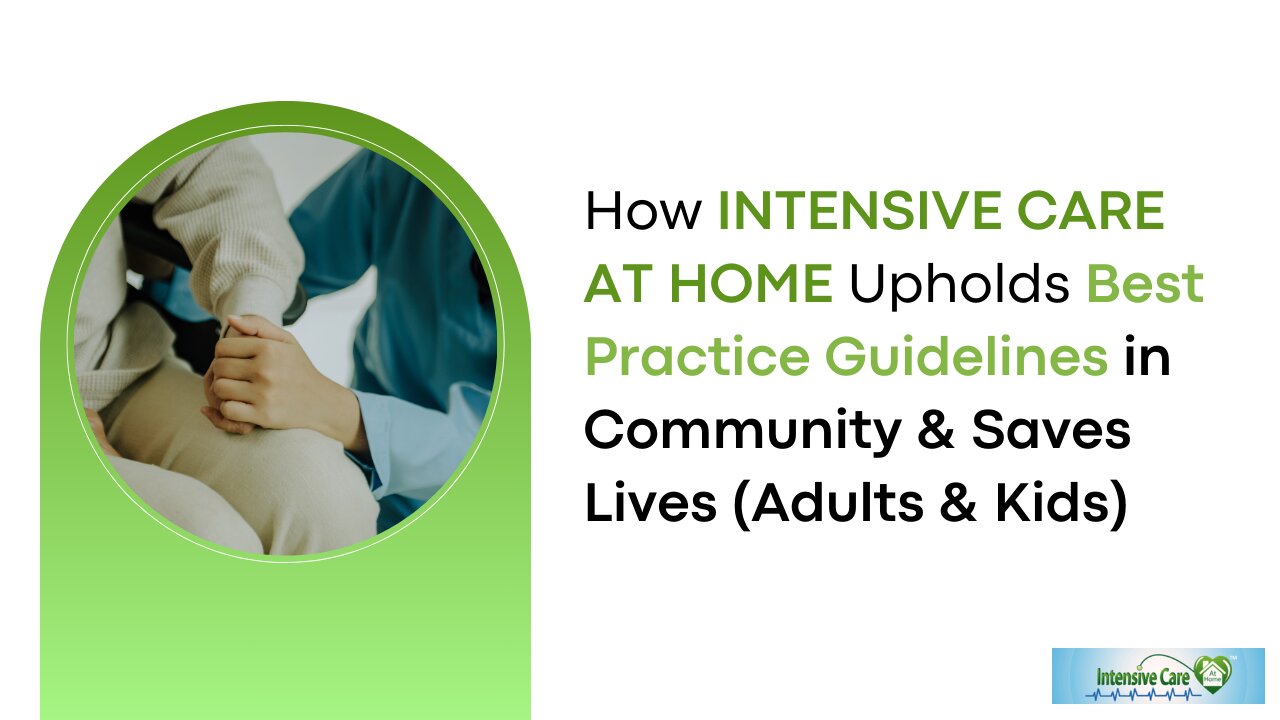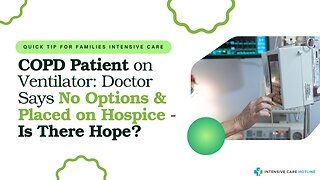Premium Only Content

How INTENSIVE CARE AT HOME Upholds Best Practice Guidelines in Community & Saves Lives (Adults&Kids)
How INTENSIVE CARE AT HOME Upholds Best Practice Guidelines in Community & Saves Lives (Adults & Kids)
Book your free 15-minute phone consultation here
http://intensivecarehotline.com/scheduling-appointment/
Call directly 24/7
+1 415-915-0090 USA/Canada
+44 118 324 3018 UK
+6141 094 2230 Australia
Email [email protected]
Get 1:1 consulting and advocacy
1:1 phone counselling
http://intensivecarehotline.com/one-on-one-counselling/
Become a member for families of critically ill Patients in Intensive Care
https://intensivecarehotline.com/intensivecaresupport-org-membership/
Immediate action steps http://intensivecarehotline.com/take-control-take-charge/immediate-action-steps/
https://intensivecareathome.com
And if you need a medical record review, click on the link and we can help you with reviewing your loved one’s medical records while they’re in ICU.
https://intensivecarehotline.thrivecart.com/review-of-medical-records/
Facebook Page: https://www.facebook.com/ICUhotline
Twitter: https://twitter.com/icuhotline
Song: Jarico - Island Music
supported by@FreeBackgroundMusicForCreators
#BackgroundMusicWithoutLimitations
https://bit.ly/2XoXFnb
#icu
#intensivecare
#criticalcare
Hi. It’s Patrik Hutzel from intensivecareathome.com where we provide tailor-made solutions for long-term ventilated adults and children with tracheostomies at home, and where we also provide tailor-made solutions for hospitals and intensive care units at home whilst providing quality care for long-term ventilated adults and children with tracheostomies at home, otherwise medically complex clients at home, adults and children, which includes BIPAP (Bilevel Positive Airway Pressure), CPAP (Continuous Positive Airway Pressure), home tracheostomy care for adults and children that are not ventilated, Home TPN (Total Parenteral Nutrition), home IV potassium infusions, home IV magnesium infusions, as well as home IV antibiotics. We also provide port management, central line management, PICC (Peripherally Inserted Central Catheter) line management, as well as Hickman’s line management, and we also provide palliative care at home.
We have also sent, and we continue to send our critical care nurses into the home for emergency department bypass services. We have done so successfully for the Western Sydney Local Area Health District, their in-touch program.
Now, today, I want to talk about a video that was published on the 1st of August 2024. Now, the video was published by the Global Tracheostomy Collaborative, and the Global Tracheostomy Collaborative is a global organization that talks about ensuring the best possible care for every tracheostomy patient, that’s what they say anyway.
Today, I will actually dismantle that, and I will actually showcase that they’re not ensuring that the best possible care for every tracheostomy patient is given because, especially in this video that was published on the 1st of August 2024, it says Navigating the Journey with a Tracheostomy: Transitions Through Childhood and Beyond. I will play some of what’s been said on that video here today, and I will then talk more about that.
So, to give you some context, the Global Tracheostomy Collaborative says that they are supposedly advocating for the best possible care for every tracheostomy patient, and that is simply not accurate because they’re not talking about the Mechanical Home Ventilation Guidelines which are evidence-based, which are published on our website.
Now, where does that fit into context? The context is this, the Mechanical Home Ventilation Guidelines are evidence-based and are a result of over 25 years of Intensive Care at Home nursing in Germany, as well as of over 12 years Intensive Care at Home nursing in Australia.
Now, the Mechanical Home Ventilation Guidelines clearly state that it’s safe only to have critical care nurses at home with a minimum of two years critical care nursing experience, ideally with the postgraduate critical care nursing qualification, 24 hours a day, once again, for adults and children at home on ventilation with tracheostomy, but also for tracheostomy without ventilation.
Now, if organizations do not adhere to those best practice standards, children have died, or adults have died. We know of at least four adults and children that have died at home on ventilation with tracheostomy or with tracheostomy without ventilation that have died in the hands of support workers or family members who simply could not manage medical emergencies. Now, if we know of four, there is probably more.
Continue reading at: https://intensivecareathome.com/how-intensive-care-at-home-upholds-best-practice-guidelines-in-community-saves-lives-adults-kids/
-
 16:51
16:51
Intensive Care Hotline
9 hours agoCOPD Patient on Ventilator: Doctor Says No Options & Placed on Hospice - Is There Hope?
21 -
 12:38
12:38
Timcast
20 hours agoJasmine Crocket HUMILIATED By CNN To HER FACE Over Epstein LIE | Tim Pool
21K36 -
 LIVE
LIVE
Stephen Gardner
22 minutes agoFINALLY! Charlie Kirk MISSING DETAILS released!
529 watching -
 23:40
23:40
MYLUNCHBREAK CHANNEL PAGE
1 day agoWe Want the Blueprints
5.06K12 -
 1:08:20
1:08:20
The Quartering
3 hours agoMTG Quits, Indian X Meltdown & FBI Caught Lying Again About Trump Assassin
114K62 -
 1:01:33
1:01:33
Jeff Ahern
3 hours ago $6.16 earnedThe Saturday Show with Jeff Ahern
27.8K21 -
 18:08
18:08
Professor Nez
4 hours ago🚨HOLY CRAP: Members of Congress Call for Military INSURRECTION!
96.5K83 -
 4:14:26
4:14:26
Grant Cardone
7 hours agoHow to Buy Real Estate With NO Money Down (LIVE Training With Grant Cardone)
95.1K7 -
 1:56:11
1:56:11
AlaskanBallistics
14 hours ago $3.71 earnedShooting the WhisperStrike WT30 Live!
14.2K4 -
 19:53
19:53
MetatronHistory
20 hours agoRome VS Greece - Ultimate Clash of Civilizations Explained
49.6K14